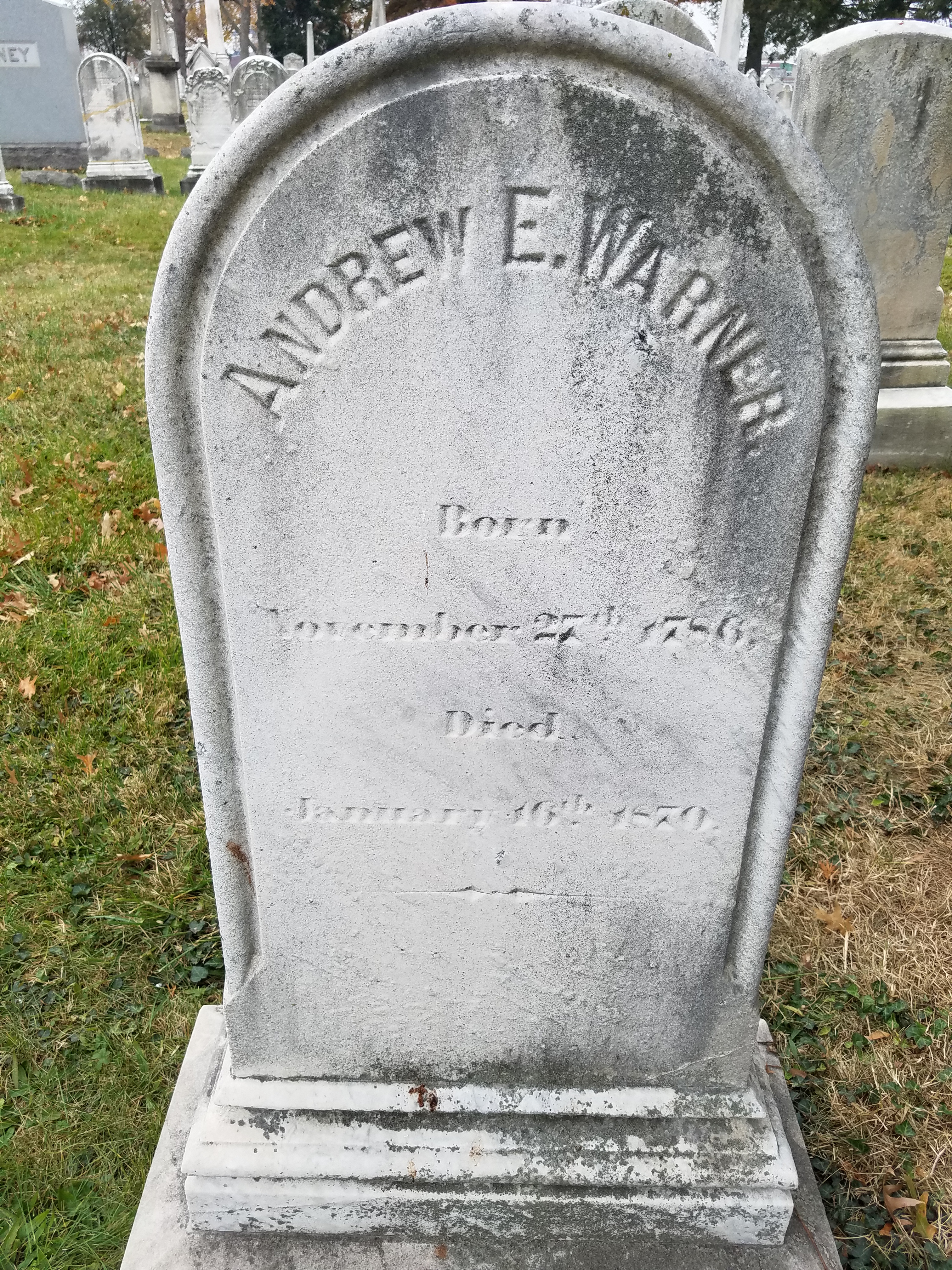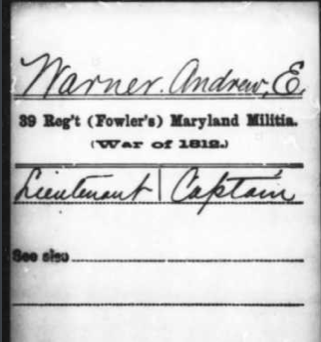Andrew Ellicott Warner was the second son of Cuthbert Hayhurst Warner, the "founding father" of the Warner silversmith legacy in Baltimore. A. E. Warner and his brother, Thomas H. Warner (1780-1828), Cuthbert's first son, formed a partnership that lasted about a decade, interrupted by the War of 1812. Thomas served in the army and was wounded in campaigns on the Great Lakes and lost his left leg. He returned to Baltimore and he and A.E. served as captains of companies in the 39th Regiment of the Maryland Militia and served in the defense of Baltimore in 1814 at North Point and Fort McHenry. Thomas Warner advertised his silversmithing services in 1813, signing his work with the mark either "T. Warner" or "T. H. Warner," and became the first city assayer of silver under the silver purity act of August 1, 1814. The act specified that he was not to make or sell silver, but he continued the trade of watchmaker. Thomas Warner married Mary Ann Meigs in 1810; they had three children, including their son, the oldest, Joseph P. Warner (1811-1862), who was a watchcase maker and silversmith and city assayer in 1844, 1851 and 1852. Thomas went bankrupt by 1820, died in 1828 and is buried in Greenmount Cemetery.
The mark of work by A. E. Warner and his brother was "T & A E Warner." A. E. Warner continued on his own after the War of 1812 and worked in silver and gold throughout the course of his life. He repaired and polished silverplate, jewelry and other luxury items, and imported and sold such items. He was commissioned for elegant presentation pieces, such as swords, goblets, medals, tea sets; for example, Richard Caton, Isaac McKim and John Hoffman, on behalf of Baltimore's citizens, presented an extravagant silver service to Commodore Stephen Decatur in 1817. Some illustrated designs for silver pieces by the hand of Andrew Ellicott Warner still exist. The mark he placed on his work was "A. E. Warner" or "A.E.W." (see attached photo)
A. E. Warner married Dorothy Litsinger in 1812, and as of the 1850 census, he lived with his 36-year old son, three daughters and an apprentice named Robert J. Cottingham, who was 18 years old. In 1869, Warner had four apprentices living in his home. A March 1949 letter from Warner's grandson, Daniel Emich, is reproduced in The Warner Family: Silversmiths to Baltimore, describes the environment in which his grandfather worked when Daniel was ten years old and his grandfather was a year before his death: "The forge in the shop was similar in appearance to a blacksmith's forge with large bellows and long arms to work it. The charcoal fire seemed to burn continually...Grandpap worked steadily and through the window I often saw him filing out the prongs of a fork or the edge of a spoon..." (Eader and Miller, n.p.)
George C. Warner, one of A. E. Warner's sons, was a jeweler and member of the Mechanical Fire Company in 1849; he kept a journal and illustrated scenes from the fires he saw, including a lithograph that shows the burning of the Front Street Theater in 1838 that was held by the Peale Museum and now by the Maryland Historical Society Museum.
A. E. Warner was President of the Old Defenders Association and had been treasurer of the Grand Lodge of Odd Fellows. He had a stroke in 1866 and died in 1870; he is buried at Greenmount Cemetery. His son, Andrew Ellicott Warner, Jr., continued operation of his father's shop and moved it to a larger space. His son, Andrew Litsinger Warner, crafted a single spoon and stated his dissatisfaction, and the Warner family legacy was officially ended. In 1893, Andrew Ellicott, Jr. closed the business.
Andrew Ellicott Warner was the second son of Cuthbert Hayhurst Warner, the "founding father" of the Warner silversmith legacy in Baltimore. A. E. Warner and his brother, Thomas H. Warner (1780-1828), Cuthbert's first son, formed a partnership that lasted about a decade, interrupted by the War of 1812. Thomas served in the army and was wounded in campaigns on the Great Lakes and lost his left leg. He returned to Baltimore and he and A.E. served as captains of companies in the 39th Regiment of the Maryland Militia and served in the defense of Baltimore in 1814 at North Point and Fort McHenry. Thomas Warner advertised his silversmithing services in 1813, signing his work with the mark either "T. Warner" or "T. H. Warner," and became the first city assayer of silver under the silver purity act of August 1, 1814. The act specified that he was not to make or sell silver, but he continued the trade of watchmaker. Thomas Warner married Mary Ann Meigs in 1810; they had three children, including their son, the oldest, Joseph P. Warner (1811-1862), who was a watchcase maker and silversmith and city assayer in 1844, 1851 and 1852. Thomas went bankrupt by 1820, died in 1828 and is buried in Greenmount Cemetery.
The mark of work by A. E. Warner and his brother was "T & A E Warner." A. E. Warner continued on his own after the War of 1812 and worked in silver and gold throughout the course of his life. He repaired and polished silverplate, jewelry and other luxury items, and imported and sold such items. He was commissioned for elegant presentation pieces, such as swords, goblets, medals, tea sets; for example, Richard Caton, Isaac McKim and John Hoffman, on behalf of Baltimore's citizens, presented an extravagant silver service to Commodore Stephen Decatur in 1817. Some illustrated designs for silver pieces by the hand of Andrew Ellicott Warner still exist. The mark he placed on his work was "A. E. Warner" or "A.E.W." (see attached photo)
A. E. Warner married Dorothy Litsinger in 1812, and as of the 1850 census, he lived with his 36-year old son, three daughters and an apprentice named Robert J. Cottingham, who was 18 years old. In 1869, Warner had four apprentices living in his home. A March 1949 letter from Warner's grandson, Daniel Emich, is reproduced in The Warner Family: Silversmiths to Baltimore, describes the environment in which his grandfather worked when Daniel was ten years old and his grandfather was a year before his death: "The forge in the shop was similar in appearance to a blacksmith's forge with large bellows and long arms to work it. The charcoal fire seemed to burn continually...Grandpap worked steadily and through the window I often saw him filing out the prongs of a fork or the edge of a spoon..." (Eader and Miller, n.p.)
George C. Warner, one of A. E. Warner's sons, was a jeweler and member of the Mechanical Fire Company in 1849; he kept a journal and illustrated scenes from the fires he saw, including a lithograph that shows the burning of the Front Street Theater in 1838 that was held by the Peale Museum and now by the Maryland Historical Society Museum.
A. E. Warner was President of the Old Defenders Association and had been treasurer of the Grand Lodge of Odd Fellows. He had a stroke in 1866 and died in 1870; he is buried at Greenmount Cemetery. His son, Andrew Ellicott Warner, Jr., continued operation of his father's shop and moved it to a larger space. His son, Andrew Litsinger Warner, crafted a single spoon and stated his dissatisfaction, and the Warner family legacy was officially ended. In 1893, Andrew Ellicott, Jr. closed the business.
Gravesite Details
Various family trees have descrepancy with his mother Ann Smith or Ruth/Rachel Hill.
Family Members
Advertisement
Records on Ancestry
Sponsored by Ancestry
Advertisement














